(cont’d from the previous post)
It wouldn’t have been long before Tiwazzo and the girls had a list of things they needed, sooner than later, before any further settling-in could be done, like cleaning supplies, buckets and bowls. J Euclide might have told them of the grocery, butcher shop and dry goods store they’d find in the 600 block of Ryan, but if Tiwazzo and Beulah were like me, they’d want to take stock of the whole 4-block shopping district for future purposes. Passing the point where J Euclide had turned off, the girls would have found the 700 block of Ryan to be more densely packed with storefronts and businesses, both sides of the street being a solid 2-story brick front of commercial buildings with no trees or greenery. Gone was any remnant of the block’s previous family presence and residential use.
~~~~~~~ 700 block of Ryan, Sanborn, 1909 ~~~~~~~

There was a bank, a newspaper, & a telegraph office… good to know. There were 6 clothing & dry goods stores and 2 shoe stores to take care of clothes and linens, 4 groceries & 2 bakeries to take care of food, 2 hardware stores, 2 stationery & book stores, a drug store, a furniture store, & a harness shop. (D.G.=dry goods, B&S=boots & shoes, H&S?= harnesses & saddles?)
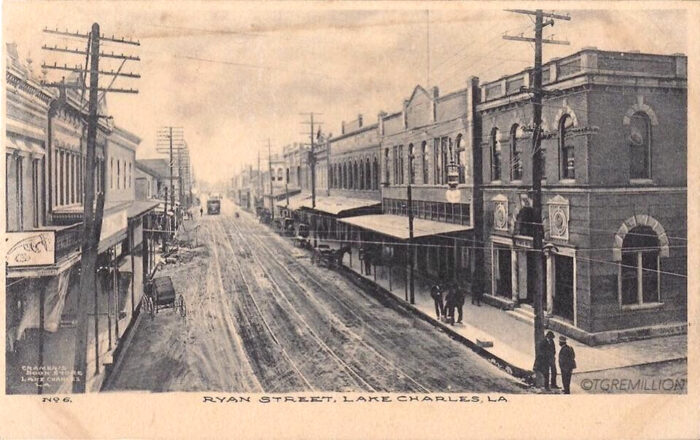
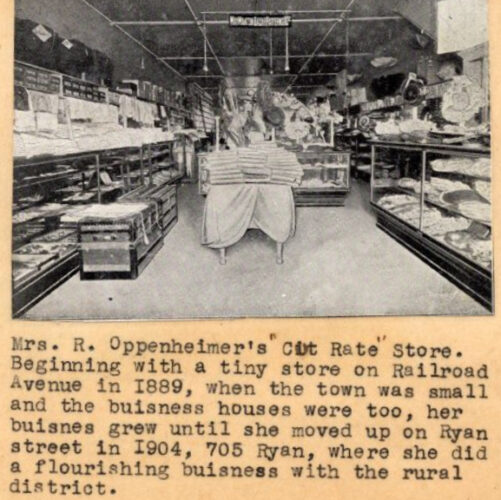
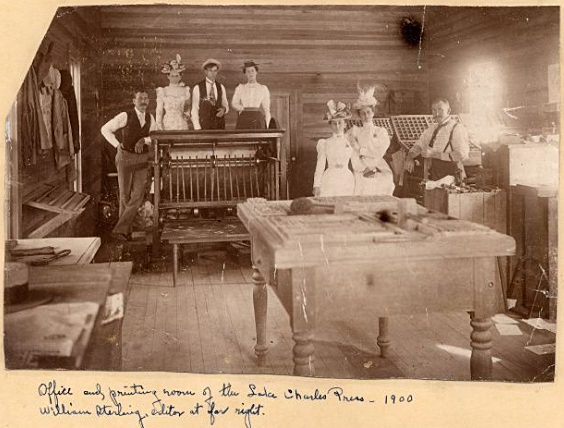
The “Lake Charles American” newspaper was the first of several businesses in two long buildings with fancy parapets along the west side, spanning the addresses 704-720 Ryan, that would have covered anything Tiwazzo and the girls would’ve needed right off the bat; groceries, dry goods and clothes, furniture, and hardware.

A few years later, the furniture store would double its size by taking over the space of the dry goods store next door, becoming 710-712 Ryan. Soon after, though, around 1916, the furniture store moved a block up Ryan, next door to Mathilde’s men’s furnishings store, and in its place, the double-size space became a dry goods store called The Hub. J Euclide and Beulah, as well as Mathilde, would’ve met the furniture people, and it’s possible that’s where they heard about the new business that had moved into the furniture store’s old space, and that it was now hiring. Presley had graduated the year before and probably wanted a job. By 1920, the census shows that both Presley and Roosevelt have gotten jobs at The Hub.
Tiwazzo knew nothing of this and saw only the merchandise in the windows as they walked past. Something that might have caught her attention across the street was one of the most elegant stores she’d ever seen, though she may have guessed that she’d never be able to afford to shop there.

Levy’s Men’s Clothing and Furnishings was touted in a 1905 newspaper article as having fixtures and shelving of solid rosewood throughout, with periodic French plate mirrors framed in the same rosewood, all manufactured especially for Mr. Levy. The Champagne women wouldn’t know it for several years, but Mr Levy’s closest younger brother Sam’s family would be their across-the-street neighbors and good family friends, the son Bernard becoming my grandmother’s best friend all through grade school.
~~~~~~~ Intersection Ryan & Broad (700-800), west side ~~~~~~~
I had help imagining what Tiwazzo and the kids would have seen when they got to the intersection of Ryan and Broad, the heart of Lake Charles’ commercial life, and it isn’t just because there is such a wealth of shots of that intersection. There is a series of 4 photos taken professionally of each of the four corners of the town’s main intersection sometime between 1903 and 1909, most likely for promotional reasons, that the Lake Charles newspaper used in a 1912 article that, some years later, Miss Maude cut out and captioned for her scrapbooks. I’d originally wanted to present the photos in this post through their eyes, with only the information that the Champagnes would have seen on the signs in front of the stores. But there is a richness to Miss Maude’s mix of fact, humor, and humanity, as well as the collection itself, that the Champagnes never got to see, and I didn’t want you not to see it either. With every caption, she draws me into the details of each building she talks about, adding to the growing context of everything I’ve learned about my grandmother’s world.
If Tiwazzo and the girls were anything like me, they would have gone to the middle of the intersection, turning first toward the water (I love water), and then continued the turn for the full 360°, taking in the four corners of what was so clearly the town’s main intersection.

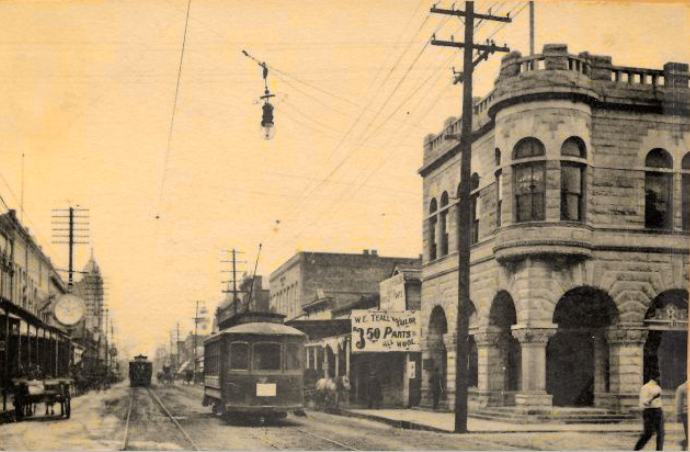
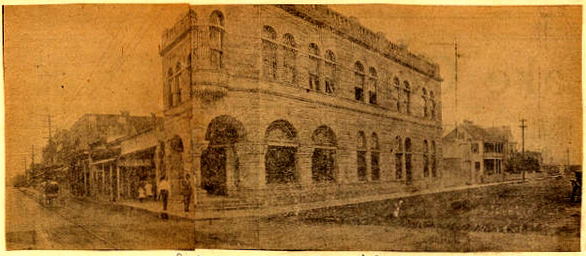
2 – Caption by Maude Reid: “Building on the corner was the Lake Charles Bank; went out of existence years ago. It is now occupied by the First National Bank. The old Chinese shop and Theall, the Tailor, were next door on Ryan street. At the right – on Broad – was the fine two-story home of Dave Bloch which was torn down in 1950. Mr. Bloch for years had a saloon on the corner where the bank stands. Before that – in the 70’s – Wm. Hutchins had ‘the Red Store’ on this corner, and his family lived in the rear. Beyond the Bloch home was the cottage where the Reinauers lived.”
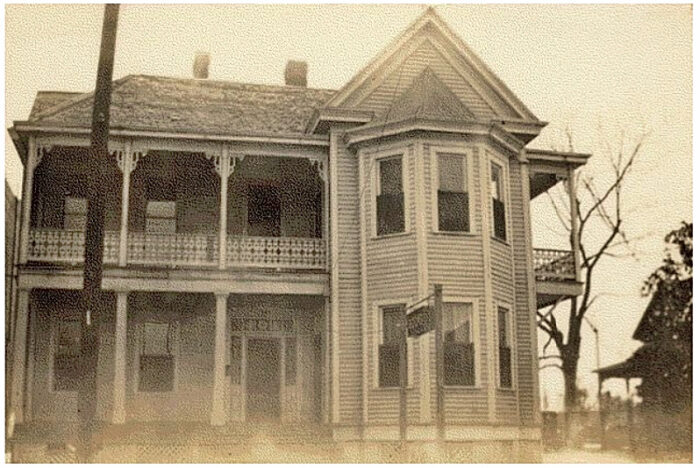
Back in photo 2, barely visible in the grainy newspaper shot to the right of the Bloch house, is a big 2½ story wholesale grocer’s warehouse compound that included side buildings, a big wharf and a railroad spur serving it. Photo 4, though, a panorama shot taken from the top of the courthouse 12 years before, captured it.

Photo 4 also captured a small, boxy building to the warehouse’ right that had a bell tower but didn’t look much like a church. Since it was there in Sanborn 1903 and gone in 1909, we can’t know if the Champagnes saw it in1907 when they were making their first exploration of the Ryan St stores. The house in between the warehouse and the bell-tower-place, closer to the bottom of the shot, is the home of one of the earliest founding fathers, Jacob Ryan, but there would have been too much greenery in the way for the Champagnes to have seen it from the intersection. Further to the right, you can see the back of the Bloch house, with its 2-storey rear wing, then at far right, the old Frank house with its asymmetrical roof line.

“This picture, taken in 1912 (sic), shows the brick building that replaced the wooden store of Julius Frank. The building still is in the Frank family [in the 1930s]. In the rear, is the old Frank home. At the time the picture was taken the Frank family had moved into a large house further up Broad street. The old Stoddard home was next door, sitting far back from the street, and next to them was the home of the Solomon family. Lorena Walker lived in a small cottage between these two. On the corner can be seen dimly the outlines of the old fire hose house where for a number of years the city council met upstairs to ponder on our town affairs. The old fire bell in the tower for summoning the volunteer firemen to duty when fires occurred was also used to call the Councilmen to meetings. Later this bell was sold to Central School, and, finally, the old bell was donated to the government for scrap in the 2nd World War.” Caption by Maude Reid

🎶 Oh, and listen to this, Ti. The place with the bell tower was the old fire hose house, and the bell went to Central School after the fire house was demolished between 1903-1909. That was the school bell that called you to school until you were 14. And there’s Lorena Walker, one of W.L. Hutchins’ children. And isn’t that the silhouette of 2 schooners to the left of the fire house?🎶
You’ve seen the Halley’s comet shot before, in the post about the Hodges St route home, but it bears repeating since this is the closest in time I can come to knowing that Tisolay had seen the same scene as in the photograph . . . during the 6-hr window that the comet was visible in Lake Charles. Newspapers all over the country talked about when the comet would appear where for weeks ahead of time, and no one who wasn’t bedridden would’ve missed it.
~~~~~~~ Intersection Ryan & Broad (700-800), east side ~~~~~~~




Caption by Maude Reid – “Building on corner is J. H. Mathieu’s Drug Store. The two-story frame building at the far right is the old Pelican Hall where so many cotillions, church fairs and big wedding receptions took place in the 90’s. One of the biggest affairs was the wedding of Rosa Reims to Sam Bendel which occurred here in orthodox Hebrew ceremony. The Daughters of the Confederacy used to hold their early meetings here, too. I particularly recall an elaborate Christmas tree party the children of the Episcopal Church had here one year – the lovely holly tree, the hundreds of wax candles aglow upon it, the strands of white popcorn and red cranberries that we children strung to decorate the tree. We had no fancy colored electric bulbs, no store-bought tinsel or gaudy glass ornaments, but we children took a delight in its magic beauty that I rarely see on the faces of our young people today. Later, this building housed the Lake Charles Press and became known as the Press Building. The American Press building now occupies the site.”

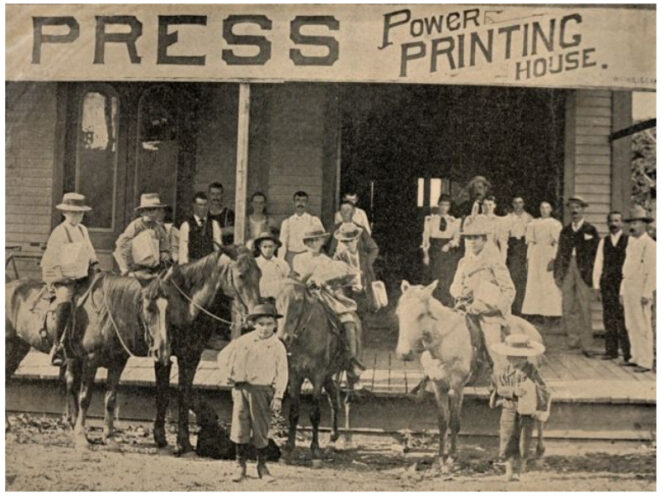
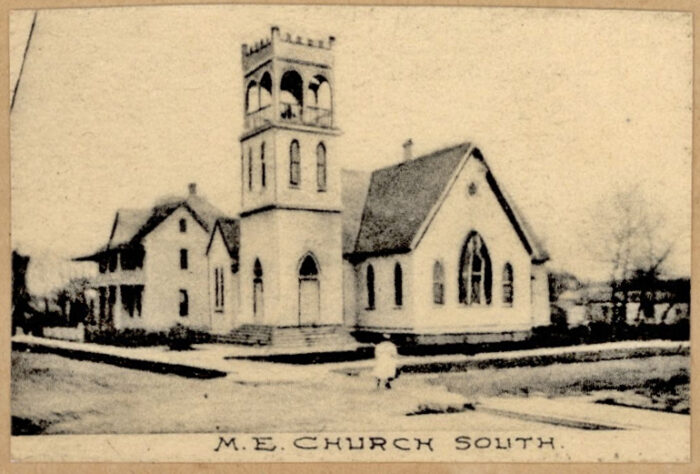

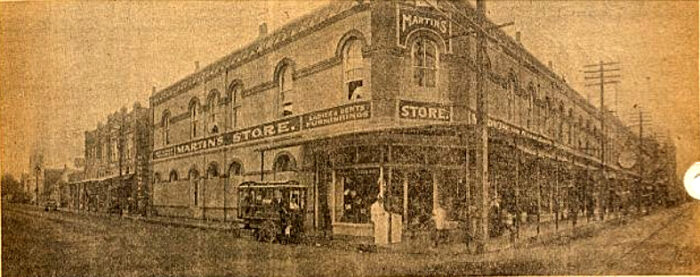
Combined captions by Maude Reid – ” In the [early 1890s] Kaufman erected the above building, later selling to Charles and Ed Martin. Penney’s store now occupies the building. The popcorn wagon shown in the picture did a thriving business there for several years.” “Kaufman built this building to replace the long skinny wooden building he rented for his general store from J G Gray, back in the 1870s, eventually becoming one of the town’s first millionaires.”
~~~~~~~ [*aside*] Hutchins corner at Broad ~~~~~~~
🎶Well, look who Kaufman rented his first store from . . . Ged Gray, little Mathilda’s grandfather. [One of Tisolay’s last piano students before leaving Lake Charles.]
You know what else? Remember a bit ago, Miss Maude talking about the Lake Charles bank next to David Bloch’s house, how it had previously been the site of Bloch’s saloon, and before that the home and corner store of Wm. L. Hutchins [Lorena’s dad] back in the 1870s?… how his family lived in the rear behind the store? Well, you grew up with those kids’ children. Those kids living next to their daddy’s “Red Store”?.. they were the parents of the kids you grew up with, part of the gang of Hutchins/Reid cousins who grew up, settled, and started their own families next door to you, behind you, and on both corners across the street from you. The newly widowed Capt. Wm Hutchins had brought them to the ‘old Hutchins House’ on Hodges St, a block away from you, when they were young, 30 years before y’all got there. He was still there when he died. You were only 3 and probably hadn’t spent much time yet with the children around you, but you may have seen him walking to and from your corner to visit his kids’ and Reid in-laws’ families.🎶
I told y’all about the ‘old Hutchins house’ in the last post, The Route Home, 1907 – part 2 of 2… how the old cranky builder-turned-judge DJ Reid had never finished building it, and when his wife left him for making her live in the Mill St home that she’d hated for 30 years. He claimed that he’d been building the Hodges house as a present for her, but then out of spite, washed his hands of the half-built house and gave it to his daughter Eugenie (Jenny) and son-in-law W L Hutchins. In 1883, 2 years after Hutchins was widowed and remarried, Hutchins’ brothers-in-law finished the house for him, one of whom being Peter Bruderson, the Foehr Islander who eventually sold one of his properties to the butcher David Reims… which in turn was replaced by the brick building that briefly housed Tante Mathilde’s store.
🎶Jeez, what a small world. Everyone knew everyone, and now I’m starting to.🎶
We know the house the Hutchins family was in before Hodges St because Miss Maude described it lovingly, a house north of town on the river of ‘fever miasmas’, as her Aunt Jennie apparently felt about it. Miss Maude had called it charming, though… something about a yellow rose arbor off the front gallery. She knew how much it meant to her father, her Aunt Jenny’s younger brother who lived with them before he was married, because he’d met and courted her mother in that house when she was a guest recuperating from the 1-2 punch of the 1879 hurricane which destroyed her Gulf Coast home, and the typhoid epidemic that followed it.
So, if the yellow rose house on the river was the one that Hutchins left in 1883 to move to Hodges, where did the house next to the ‘Red Store’ on the corner of Broad and Ryan fall in the sequence? David Bloch, who Willy Hutchins sold the place to, didn’t immigrate from Alsace until 1875, so the corner house with the store was probably the one he sold to Bloch to go to the yellow rose house. Actually, evidence points to the corner house being the one Hutchins’ father built 20 years before, when he first moved his family to Lake Charles from Opelousas in the mid-1850s and Willy was just a boy. There’s a promotional history of Lake Charles in the 1895 directory that describes what Lake Charles looked like during the Hutchins family’s first years there, an unincorporated little outpost that barely had 2 dozen houses spread around a checkerboard of dirt paths that didn’t merit street names yet, which means that this little house at the intersection of 2 dirt paths that weren’t even named Ryan and Broad St yet, was one of the very first homes, and Hutchins one of the first pioneers.
But the census indicates nothing about a store, nor anything about anyone in the family being a merchant or storekeeper. His father, still in the family business of printing in Opelousas in 1850, had gotten a job in Lake Charles as a brickmaker by 1860, but he’d taught his boy the printing trade, which is how young Willy was working when he was 16. The earliest Sanborn map doesn’t get made until 1885, long after W L Hutchins was grown, widowed, remarried, and in his last home, but it still tells a tale. It shows the house centered on the lot, as though the idea of putting a store, or any other substantial structure, on the property hadn’t occurred to anyone yet. The store is squished awkwardly into what space there was between the house and the street corner.

I think the events of 1865 set things in motion. Hutchins returned from the Civil War and made plans to marry Eugenie(Jenny), but two weeks before the wedding, his father died. Man of the house now, William had to support his mother, younger sister and baby brother, as well as his new wife and the babies that would start coming soon. Were times as desperate as they were everywhere else during Louisiana’s destitute post-Civil War years? In Feb of 1868, he and his mother allowed his sister to marry at the very young age of 15, into the family of the town’s first lumber mill owner, Jacob Ryan, whom they’d all grown up next to, something I think is rather drastic if financial need and his sister’s security weren’t an issue. But Lake Charles was a lumber boomtown, made more so by post-war repair and rebuilding, which provided a financial buffer for the tiny settlement. How much worry was there? William might have had a good job as a printer with the Lake Charles newspaper, which his uncle had recently been hired away from Opelousas to run. Plus he’d either inherited or been able to buy investment land, because he sold a piece of it in 1869 to the Catholic church which was expanding.
In any case, the following year, in 1870, the census lists him as a merchant for the first time, and his neighbors look like the same ones as were in the 1860 census when his father was still alive. But he was not a merchant on the corner of Broad St quite yet, as Miss Maude remembered, with ‘the Red Store’ on the corner, in the 1870s and his family living in the rear’. Two blocks south, on the south side of the town square, a drawing of that block from the same year as the census shows the tiny newspaper building that had been run by his uncle until the previous year, the boarding house next to it that his aunt had been running, and then William Hutchins’ store, which may have been on his aunt’s property. Was he supporting his family with that store while building the corner store next to his home, the one Miss Maude remembered him being in during the 1870s? Given how the southern boundary of the street doesn’t line up, with the west side of Broad being a bit further north than the east side, I think he simply moved the store he’d built on the town square. They routinely moved houses, much bigger ones than this.
One of the oldest photos of Lake Charles, from 1882, shows the Hutchins home and store, at left, center, after Hutchins had sold it to Block.

It’s too bad that Miss Maude’s caption for this photo includes nearly every building but the Hutchins’. About one of them, directly across the street at right, she wrote, “The long building on the corner was the property of Ged Gray – who rented it to Leopold Kaufman . . . . The white house beyond is the home of George Ryan [husband of Hutchins’ sister], and the house still further on was that of Frank Gallagher“.
🎶Now there’s some perspective for you. Your daddy saw the Gallagher house on his first walk to the SPRR freight depot, 25 years after this shot was taken when it was the lone remaining residence in the otherwise commercial corner of Mill and Ryan.
When Kaufman rented his store building from Ged Gray, Gray was just a young surveyor and cattleman in his early 20s, accumulating grazing land all over the marshlands of lower Calcasieu Parish. That was before someone found oil on all that land and the Grays became crazy ri h millionaires. I wonder how Kaufman’s millions stacked up against the oil fortune that eventually came to the Grays. He was little Mathilda Gray’s grandfather. Her aunt [also named Mathilda] was the one who gave you that gorgeous yellow Belgian lace handkerchief for a wedding present.
Little tidbit that amused Miss Maude. When Ged’s father died and the last of his siblings was grown and gone from the old Gray home a block down Broad from Kaufman’s store, it was Leopold Kaufman who bought it. When he was wealthy enough to build a grand mansion on the fast-becoming-prestigious Broad St address, he moved the old Gray home (in the words of Miss Maude), “not bothering to turn it about as it went across the road. So the back of the house fronts on Bilbo street.” It stayed like that, too, until it was torn down in the ’40s.🎶
And here’s another tidbit for perspective. Imagine you’re standing at the intersection between the Hutchins and Kaufman stores in that 1882 shot, but facing south, with the Kaufman store at your left and the Hutchins home and store at your right. Just 7 years later, in 1889, Bloch’s saloon having replaced the Hutchins buildings, the block was packed, as the faded photo below shows. Gone are the yards and picket fences and trees. Not only had the railroad finally cut through the forests of SW Louisiana, opening the little town up to the major ports of both New Orleans and Houston, but the government opened up the forests for sale at $1.25 an acre, and a Kansas land investor with a vision bought 1.5 million acres of SW Louisiana forest, then advertised the potential of Lake Charles all over the country. Lumber barons from the northern states flocked to Lake Charles, and their Broad St mansions began sprouting up in the ’90s and ’00s.
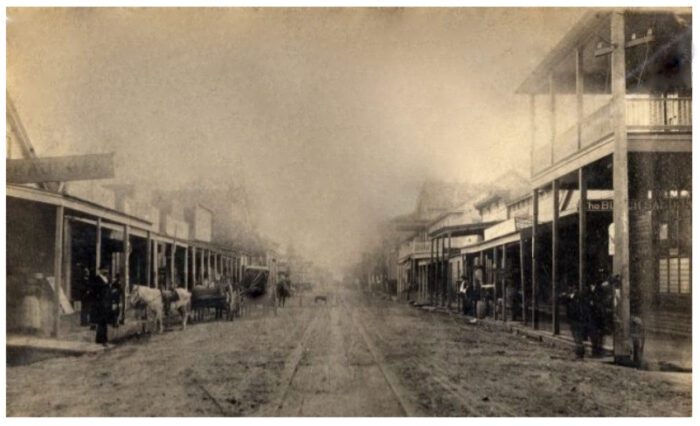
But that’s a little far afield. As for Hutchins and his store, if there were financial hard times, they didn’t last. In the mid-70s, Judge Reid loaned his son-in-law the money to buy into a lumber mill on the river on the north edge of town, which Hutchins also managed. This is what prompted his father-in-law to build them a home next to the mill, overlooking the river, with a verandah where Eugenie would plant her yellow rose arbor.
🎶I wonder how Hutchins came to be the captain of a mail boat that went back and forth to Cameron, on the Gulf coast.
No, what I wonder is why so many of my little lines of research keep bringing me back to the Hutchins/Reid clan. Hutchins’ brother-in-law Peter Bruderson’s property ends up being the site, 50 years later, of Tante Mathilde’s store. And the house that Judge Reid’s wife hated?… that’s the house that was replaced by the Bel mansion, which was where I first found you at the very beginning of my Lake Charles research, at the Bel’s garden party when you were 8. I feel like fate keeps steering me toward the Hutchins/Reid clan because of some ‘disturbance in the force’, maybe because you were supposed to have married one of them. Was there some great love that was supposed to happen, but something intervened? You never talked about dating anyone in high school, which I always thought suspicious. Hmmm… of all the older gang of Hutchins/Reid grandchildren on that corner, Earl Reid and his twin sister Audrey, the youngest, were only 2 years older than you. Actually, Earl was Hutchins’ nephew-in-law twice over; Earl’s dad being his first wife’s brother, and Earl’s mom being his second wife’s sister. How this is apropos of the Champagnes, I don’t know, but I wouldn’t want to be around when anyone told Granddaddy that destiny had meant for you to be Mrs Stella Reid🤣.🎶
Sorta brings to mind the image of him huffing and puffing, the day I showed Tisolay how to hop the iron spike fence at the cemetery to see him that first All Saints’ Day, when we’d gotten there too late, after closing. All the tourists, in dead silence, their cameras forgotten around their necks for once, clapped and cheered when we made it down the other side. She shook her fist up at the sky and said, “and there’s nothing you can do about it!” , but I could see him, lightning bolt in hand, fixin’ to zap my a** but good.
~~~~~~~ 800 block Ryan ~~~~~~~
Continuing down Ryan, Tiwazzo and the girls would find the 800 block even more packed. There were 2 banks, a post office, a telegraph office, 2 hotels, the Kansas City Southern railroad office, a stove store that also carried sewing machines, and 2 barbers. There were 2 big department stores, a dry goods store, 2 men’s furnishings stores and 4 tailors, as well as a millinery, a shoe maker, and 4 jewelry stores! There were 5 restaurants & cafés, a large grocery store, 2 fruit stands, a meat market, and a confectionery. Entertainment was also found in abundance on this block, in two 5¢ theaters, 2 movies theaters, 1 sporting goods store, 4 pool halls (some with cigar & tobacco shops, often above saloons), and speaking of saloons, 9 saloons… on a single block.
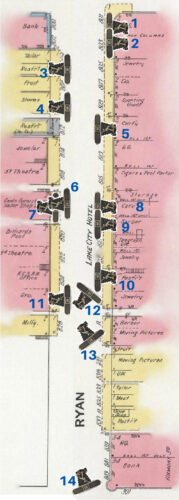
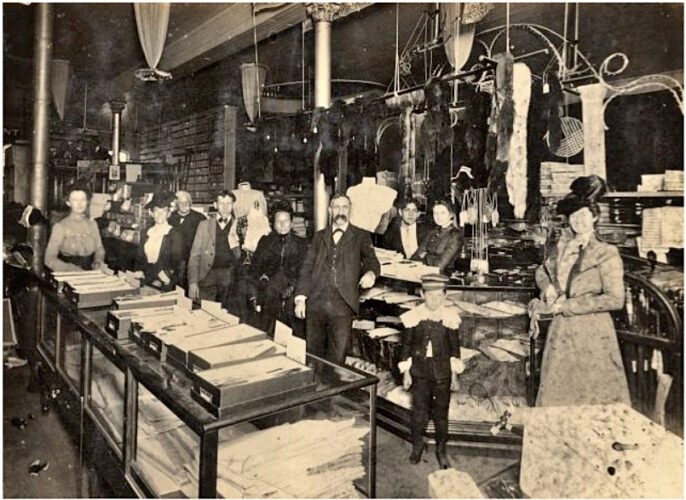

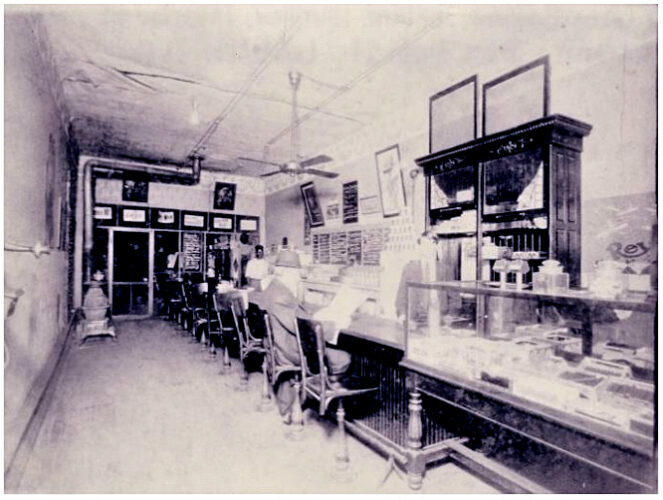
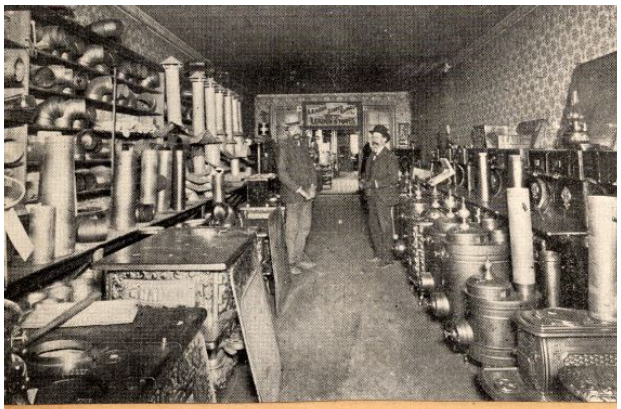
🎶Look, Ti,… C.M. Braden, that’s Mary’s grandfather. [One of Tisolay’s piano students] You might have met him if he went to Mary’s recitals. If Tiwazzo bought a new stove from him, it would’ve only been a few years after this shot. I was thinking… Even if Mathilde had brought her stove with her from her old house, it’s likely that it was too small to make the jump from a 3-person household to a 10-person household, counting their boarder. Did the two families go in together for a large stove? And how about room heaters? Mathilde wouldn’t have had enough room heaters for a big 2-storey house. So it’s possible you saw Charles Braden and his store, if not in 1907, then maybe after you moved to 617, when you were 7.
You certainly would’ve met his son William at Mary’s recitals, though you probably dealt mainly with his wife. Mary’s dad became a judge, and apparently owned one of Lake Charles’ first cars. Take it away, Miss Maude…🎶

Caption by Maude Reid – “One of the first automobiles in Lake Charles – 1910. Although automobiles were being manufactured in 1898, it was not until 1902 that we saw one on the streets of our little town. Then William Ramsay, one of the large mill owners, bought a “horseless carriage” and tried to use it – “one-bigger” Winton[?] The whole town laughed at his efforts to make it go, quoting the adage about a fool and his money, that the things were nothing but toys for rich children to play with and could never be put to any practical use, and so on. We had terrible roads then – only one or two streets in town were paved – and outside of town, in rainy weather, they were almost impassable. . . . In a short while, J.A.Landry bought an electric car [Carmen’s future grandfather-in-law]. Then a few other daring souls followed with the purchase of a “horseless carriage” and dared the comments of the town by driving them – but only on sunny days when the streets were dry. . . . Typical of those early cars is the one pictured above, It was purchased in 1910 by C M Braden from a manufacturer in Indianapolis and was a Waverly electric carriage. Mr Braden invented the front seat that you see in front of the driver. The driver is his son William, now Judge Braden, and the girl next to him is Laura Dees, next to her is Carrie Freck?, and on the sidewalk are Mr & Mrs Braden. – In front of the Braden house northeast corner of Cole and Clarence Streets.”
🎶Turns out, the Bradens lived across the street from William L Hutchins’ cousin Mary, the daughter of his uncle Bryant Hutchins, the newspaper printer, which means the photo of Judge Braden in his car was taken from in front of Mary Hutchins Kaough’s home. It was her husband Joseph’s kid brother Tom, an experienced steamship captain, who died of exposure at the age of 43 on a hunting party on foot out in the marsh, having gotten lost. His friends didn’t find his body for days. His widow died only 3 years later, leaving 4 children that were taken in by her sister’s family, that of the esteemed judge and attorney general Edmund Miller. That’s a story unto itself and will come up in the next post.🎶

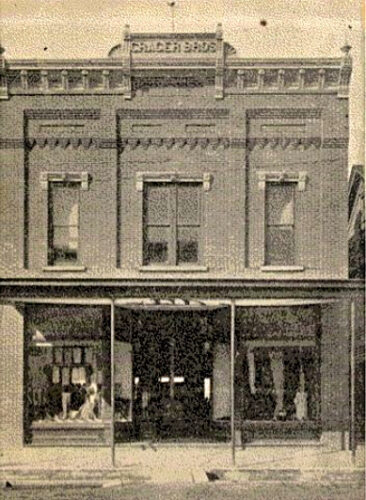
6 – 818 Ryan, Caption by Maude Reid: “Crager Bros. dry goods store, built in 1890 … was the first brick store erected in town. Built in 1890. Mr. Louis Crager married the sister of Mrs. Sol Bloch, a Miss Loeb of New Orleans. The store was where the Moss building is now. The firm was composed of Harry and H. A. Crager of Orange, Texas, and Louis Crager of Lake Charles. And they were shrewd business men. This was the first store to give you change in pennies. Before that if your bill came to $1.59 the store keeper kept the penny change. The local paper referred to them as ‘old New York City dry goods clerks.’ This store was considered the best and biggest between New Orleans and Houston in 1895. Doing a retail business aggregating $100,000 a year.” – McNeese archives

7 – Crager dry goods store, 1892 – Caption by Maude Reid: “… Notice the display of goods – shoes in the foreground, surmounted by straw hats, neckties hanging from open umbrellas suspended from the ceiling. Closed umbrellas hanging at the left. Other articles of wearing apparel on lines strung across the shop in the rear. This was the swankiest store in our town.“
[* aside*] Louis Crager died in 1899, and a few years later, Lithuanians Ezrael Kushner and his wife took over the old Crager building and opened a dry goods and clothing store, The People’s Store, which remained there until Tisolay went off to college. Some months after the fire of 1910, the Kushners built a fine home for their 7 children, all the same ages as the Champagne kids, 3 doors down from 617 Moss where the Champagnes were soon to move. The Kushner kids had a boatload of musical talent between them, and they were all over the archives, as well as the recital programs in Tisolay’s scrap book. A 1911 shot of the high school orchestra shows Maurice in the first violinist’s position, the most prestigious in the orchestra, Abe playing the clarinet, and Louis on the cornet. Sam, Roosevelt’s age and not yet in high school, played the cello. Music was not their only art, either. One of Ezrael’s grandsons went to Juilliard in New York, and his son Tony wrote the Tony-award-winning play Angels in America. The youngest Kushner daughter Florence, a few months older than Tisolay, played the violin and went to the New Orleans Conservatory of Music with her, and Ti had a photo portrait of Florence in with all her old photos.
It was strange; several times over the years, I’d forget who she was and ask again if the girl had been a friend of hers. She always said no (though not with any irritability in her voice), that she was a girl who went to the Conservatory with her. There’s no way, though, that growing up 3 doors from each other, and being musicians, they woudn’t have had the chance to be friends if they’d wanted to. Maybe it was simply a personality thing, and they just weren’t drawn to each other. But then, maybe Tisolay was intimidated by how much more musically advanced everyone in that family was. Maybe without meaning to, Florence made Ti feel like a country bumpkin, out of her league, which was true, truth be told.
This never occurred to me until after Granddaddy died, when I found that he’d kept all of her letters to him during their courtship years in a trunk in the attic. She had kept all of his as well, but hadn’t looked at them for 50 years, so I read them all to her, in order … his, hers, his, hers, like the 4-year-long conversation that they were. One of the main themes of the later ones was about Tisolay’s refusal to marry him because she said the call to be a performing concert pianist was so much stronger than the call to marriage. It was clear that her great affection and respect for him simply didn’t equal the passionate love he felt for her. One of the letters to him wasn’t from her, though, but from her piano teacher, a performing concert pianist herself who taught for periods in between her travels across her performing circuit. She had become a dear family friend, and her letter was in response to an anguished letter Granddaddy had written her bemoaning the fact that Ti refused to marry him, and he didn’t understand her using the piano as the excuse. Madame Schaffner was plainly in his camp on this matter, and admitted to him that Tisolay had started lessons too late, and while she may have wanted it with all her heart, she simply would never have the ‘chops’ as a concert pianist. As a pianist myself, I know that it’s true. Her repertoire had never reached the level of difficulty required. I think half the town’s support of her and her music, paying her tuition and board at the Conservatory, was just because of how adorable she was and how much she loved playing for them.
🎶I’m sorry, my precious girl, but it’s true. It occurs to me now how anguishing it must have been to you when you first realized this, and for the people who loved you and didn’t have the heart to tell you. Strange. Why don’t I remember feeling anguish for you when I first read you that letter? I wasn’t yet 30. Was I really that clueless? I’m so sorry, about so many things I never thought to ask you about… not about facts, but about your feelings about them. (🤬But then, when I did, you’d never tell me). I adored your music, you know that, and you know that learning several of your pieces so I could ‘keep hearing you’ brought me comfort after you were gone. Still do. But it’s true.
What about the others, though? Carmen was Abraham’s age; did they not share any flirtation, even just meeting each other at the grocery store across from the Kushner home? And Morris and Sam were Presley and Roosevelt’s age. Who knows; they may well have been friends. But looking at Presley and Roosevelt’s paths in life, compared with the Kushners’, it makes me wonder if there weren’t a cultural divide there, too, and not just the Jewish-Catholic thing. Karl and Bernard were Jewish too; that didn’t stop y’all from being best friends. I’ve sometimes wondered if your description of your father as sweet and gentle weren’t somehow ‘code’ for passive and unambitious. Well, Presley was content to be a salesman at a clothing store all his life, never marrying, living with his mother until she died, then moving back in with Aunt Mathilde and Mildred in the house he’d grown up in. Roosevelt as well, never marrying, joining the Merchant Marine after his father died. So it’s not surprising that the Jewish immigrant culture could have seemed a world apart for the mild-mannered Champagnes. The immigrant generation, so often coming from a modest background, encourages their 1st-generation-American children to excel at education, intellectual pursuits, the sciences and the arts. The 3 oldest Kushner boys were a doctor, a jeweler and an optometrist, then Ezrael left the store and started a lumber planing mill, and his younger children joined that business. Florence stayed with her music and taught violin.🎶
Maybe I’m reading too much into her stating that they were not friends and it’s a non-story. Ah, well, another mystery destined to remain so.
~~~~~~~
Back to Tiwazzo and the girls’ exploration of the Ryan St stores. We have to remember that they knew nothing of such little histories we’ve learned from Maude Reid’s captions. They simply made note of what stores and businesses had signs to identify themselves.

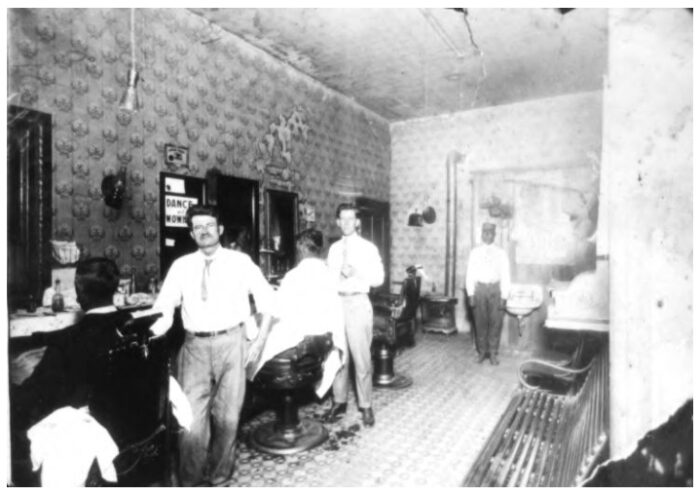

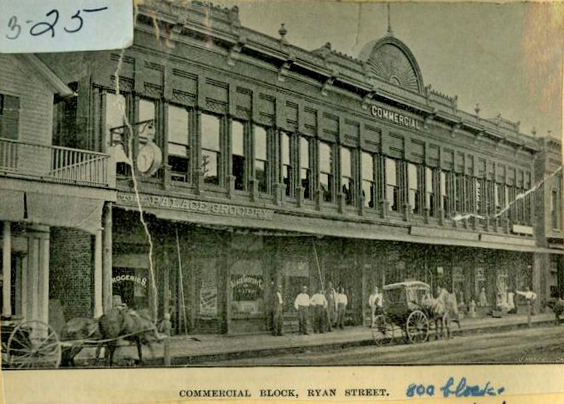
11 – Caption by Maude Reid – “The Palace Grocery is just above. Crager Bros. store to the extreme right. The wooden building at the extreme left is that of the grocery of Julien Richard whose family lived upstairs. Later, Hollins and Trepagnier occupied the downstairs with a jewelry store.” [*Correction – Miss Maude’s a bit off. Julian Richard’s grocery store was a nearly-identical 2-storey wood-frame storefront adjacent to the left of Trepagnier’s jewelry store.] – McNeese archives
When Tiwazzo and the girls walked past the storefronts in the beautiful Commercial bldg, they wouldn’t have had much interest in the Arcade Pool Hall, or much use for the Kansas City Southern railroad office. But they might have perused the posters of coming attractions at the Imperial Theater, and certainly would have taken note of the Palace Grocery store, one of the biggest and longest-running groceries in town. They may have looked up to notice the lovely sunburst parapet, Eastlake, somewhat reminiscent of the delicate doorframe woodwork of the early Reid home on Hodges that Miss Maude didn’t like, favoring Mrs. Muller’s big boxy Lake Charles-style columns. But they would have seen no significance in the long row of 23 second floor office windows below it. They didn’t know that in 10 years’ time, in 1917, after Mathilde’s men’s furnishings store failed after only 3 or 4 years and left J Euclide without a job, he would be working behind one of those windows as an insurance agent for Life Ins. of Virginia. Perhaps the coming of WWI had an effect on sales in a men’s furnishings store, and perhaps insurance companies’ war exclusion clauses affected policy sales as well, but by 1920, J Euclide had changed jobs again, working in sales at a dry goods store, while his 2 boys were at The Hub.
So much would change for the family in the 10 years between 1907 and 1917.

12 – Before refrigeration, grocery stores usually only handled dry foods in boxes, bags or barrels, or things preserved in cans or bottles. People often got their vegetables and fruit straight off the farmer’s wagon which clop-clopped its way every morning through the neighborhoods, calling out his wares to announce his approach. But this grocery offered produce to their shoppers and the chance for a farmer to drop off his whole wagonload at one time, costing a bit of his profits but saving greatly on time. If those cases at left gave the shopper the chance to skip the bakery as well, this could explain the Palace Grocery’s longevity.

13 – Caption by Maude Reid: “Headed by the First Regiment Band of Lake Charles, a parade of women and children, hundreds of them, marched down Ryan street waving flags and carrying transparencies with mottoes urging voters (men only, then) to vote out saloons in the town. This parade took place the day before a parish vote was taken on the liquor question for Calcasieu … Even the sisters from the local convent marched in the parade – for the first time – heading a group of little girls with banners asking that the voters ‘Protect Our Homes’ and ‘Vote for Us.'”
Hollins & Trepagnier’s jewelry store later became a butcher shop, and by 1909, a millinery store. Meat market or ladies’ hat store, the photo shows that in 1908, the building saw a parade that was very likely also seen by the Champagne family. The building was a bit worse for wear, though, its side wall chopped up with doors moved and its bannister missing. And a dead tree seems to back up a caption from Miss Maude elsewhere that said a fire took out the wooden corner buildings. Besides Julien Richard’s store, old Madame Paul Gascon LaFargue’s home and grocery store on the corner are also gone. Lucky jewelry store.
Because of this shot being from June of ’08, a year or less after the Champagnes’ arrival, I felt reasonably comfortable opening the 800-block section of this post with the 1909 Sanborn map detail that showed the corner as an empty lot. But now I’m not so sure that’s what Tiwazzo and the girls first saw as they came to the end of that block. It took a tiny background corner of a photo of the newly-opened Majestic Hotel from 1906 to make me question whether maybe the LaFargue compound of buildings were still there when the Champagnes arrived in 1907. (Why is this important? It’s not, really, but these rabbit holes lead to such interesting tangents.) Several photos of the 900 block of Ryan gave me glimpses of the LaFargues’ corner, and I looked further into who the LaFargues were, hoping to pinpoint just when these buildings came down.
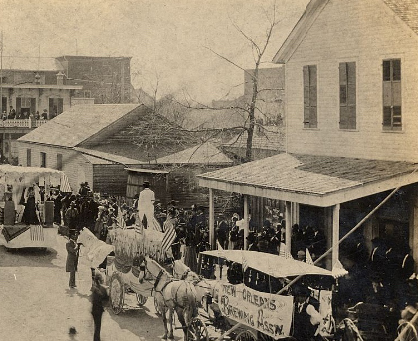
14 – Caption by Maude Reid “A trade parade in 1895, Ryan St, J. V. Richard’s grocery store at right; Madame Paul Gascon’s general store on the corner, … Meyer’s drug store on the opposite corner [which by 1907 had become Eddy Bros dry goods], and the Williams Opera House. … One of the horse-drawn floats features a flag of the New Orleans Brewing Association.”
LaFargue’s corner store had a cistern fed by a pipe coming from the roof gutter (y’all know I love cisterns). It probably served both the store and the home, seen to the right of the store. Its smaller roofline is faintly visible, and seemingly on top of it (but actually on Jerry O’Brien’s 2nd-floor verandah next door), people are gathered at the O’Brien home above his furniture store to watch the parade. The 2-storey squared shadow that looms as a backdrop to the O’Brien porch is the Rock Hardware store. Tiwazzo and the girls will see the O’Brien place and Rock Hardware, and maybe the tiny LaFargue home when they reach the intersection of Pujo St.
~~~~~~~ intersection Ryan at Pujo, west side ~~~~~~~

Two photographs and a painting illustrate the changes of the first two blocks of Pujo St: the first from 1882 when the little lumber milling outpost seemed barely aware of the significance of the railroad having penetrated the surrounding forest just two years before. A watercolor from 8 years later, in 1890, seems little changed, with no sign of the public wharf and market that would come. But by the time the 1895 panorama was shot, a full 360° taken from atop the new courthouse, Lake Charles was fast becoming a boomtown. Two houses serve as common factors that help to orient the 1882 shot, the 1895 panorama, and the 1909 Sanborn map to each other. Sanborn, above, shows the old home of Dr Erasmus Lyons, first licensed doctor in Calcasieu parish, next to camera 8, and the home of Mr Nettlerode, a billiard hall owner from Cöpenhagen, above camera 9. (Don’t feel like you have to follow this, unless you are really into plotting things on maps.)

1 – The street itself is glimpsed between two whited-out areas along the bottom which represent structures that were no longer there by the time the Champagnes arrived in 1907, having been replaced by two 2-storey brick storefronts. To the left of these whited-out areas is the “T”-shaped, 1½ storey cottage of Dr. Lyons, and above that at far left, facing the lake, the large 2-storey Nettlerode home. (Remember these two houses; they’ll be landmarks to orient you between photos later.) Continuing right from the Nettlerode home, across from Dr Lyons, is the small, 2-story house with verandahs where two young school teacher sisters taught school downstairs and lived with their mother upstairs. Behind the school is the 1½ storey home of Captain Hansen, and beyond it, the wharf and mill of Jacob Ryan, the first lumber mill in Lake Charles, can be seen in front of his home (with chimney and wrap-around 1st floor verandah). To the right of the Ryan homestead is the dirt path that will become Broad St, visible at far right. The two houses at lower right are, left, the small home of Jerry OBrien which will later be rented to the nuns as ‘the first convent’ while the real convent was being built. Next to it is O’Brien’s furniture shop with the bell-shaped façade. You will see this house later as a 2-story because O’Brien built the second floor for his family’s home the same year as this photo so they could leave the tiny cottage, which was then rented to the nuns. The upstairs balcony of that raised home would be where the family watched the 1895 trade parade from, in the previous photo. The Champagnes would know this house as a boardinghouse for many years, but not in its position in the photo. Around the time they got to Lake Chrles, it was moved closer to the lake, a few doors on the other side of the nuns’ cottage.
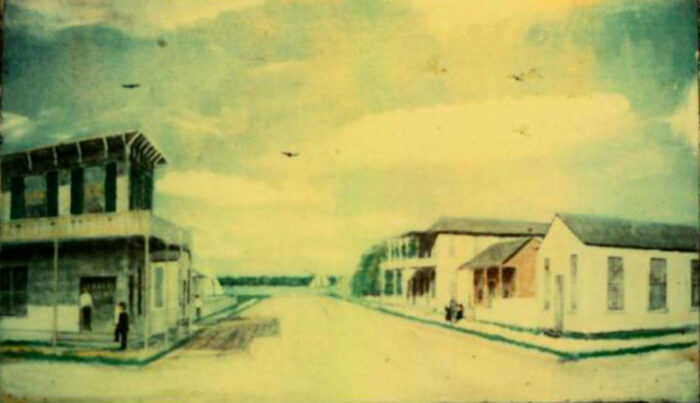
2 – 1890 painting – I’ve shown you this painting before. It’s problematic. You won’t find the Lyons or Nettlerode homes in it, since Lyon’s home is set too far back behind Meyer’s drug store, at left (which will be the big brick Eddy’s Dry Goods store), and the Nettlerode’s home is hidden behind a tree at the far end of the right side of Pujo. And it was likely painted from a faulty memory. Miss Maude identifies, correctly, the corner house at right as “Paul LaFargue’s Bar” (perhaps the store’s nocturnal identity😉), and the 2-story building a couple doors down as the O’Brien home and furniture shop, which had been the 1-story shop with the bell-shaped parapet in photo 1. But the red cottage in the middle is wrong. That’s the convent, which should be on the far side of the O’Brien place, set too far back from the street to be seen. The nuns are even painted in, though they would have long been in their new convent next to the church. What should be there is the tiny home of the LaFargues, whose roofline was aligned with the roof of their store next door. By the time the Champagnes stood in this spot looking at the lake, the left side of the steet would be all brick, 2-story stores.
What interests me, though, after looking at McNeese’s hundreds of beautiful old sepia and black-and-white photos, is that it reminds me of the world of color that was the reality of those living amidst a lush green forest, on the edge of a blue lake… not sepia. (The lake wasn’t actually blue; the sky it reflected was blue. But it was, and still is, a clear, clean green since, contrary to what many think, there is no tributary that links the clear Calcasieu River to the muddy Mississippi River Delta system.
🎶Aw, Ti… now, ya’ see? This is what comes of reading and re-reading Miss Maude’s every caption, regardless of whether the photo is relevant to you or not. I just ran across a shot I’ve long ignored of that post office behind Meyer’s, which had a zoo in its back yard or some such, because it was long gone by the time y’all arrived and had nothing to do with us. But Miss Maude’s caption just said, “Mr. Dennis Foster was the postmaster… appointed March 1890 [the same year as the above painting]. The Fosters were then living in the old Nettlerode home, a large rambling building that stood on the north-east corner of Pujo and Front streets”. Young J Alton Foster, Blair’s dad, would’ve been 11 years old. He would be married, widowed, and remarried by the time he sent Blair to you for lessons. He’ll forever be a debonair-looking 52 in the portrait of your wedding breakfast party, just like Blair and Betty Bird will forever be the two flowergirls sitting in the grass in front of the table.🎶

3 – Most of these structures looked much the same 12 years later when the Champagne women were taking their first walk to check out the Ryan St stores. At far right, three 2-storey brick buildings, seen from the rear, are (right to left) Rock Hardware, Loree Grocery, and a vaudeville theater. Left of them is the sloped roof of the Lyons home. The Pujo St wharf and ferry landing are at the top left, and the old Market Hall, with its bell tower, now obstructs what had been the Nettlerodes’ (now the Fosters’) lakefront view.
Again, I have to remind myself that Tiwazzo and the girls knew nothing of the history of Lake Charles or its citizens, or its buildings. All they knew was what they could read on the shop signs. Standing at the interection looking toward the lake, Eddy Bros dry goods would certainly be worth remembering, though they’d passed several dry goods stores already. Past Eddie’s were the 3 new brick 2-story storefronts… Rock Hardware, Loree Grocery, and a vaudeville theater, all worthy of note. If the old LaFargue’s corner had not burned yet, they’d have seen a chinese laundry and a saloon in their old home and store, sold after the 1901 death of the Widow LaFargue. The old O’Brien building, moved before the fire, would have been a restaurant with a fruit store in the old carpentry workshop, or a boardinghouse. But the rest of the street to the ferry landing, on both sides, were residences.
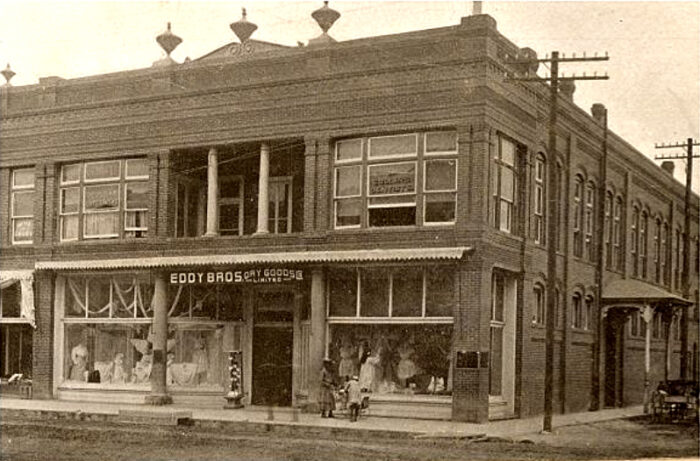
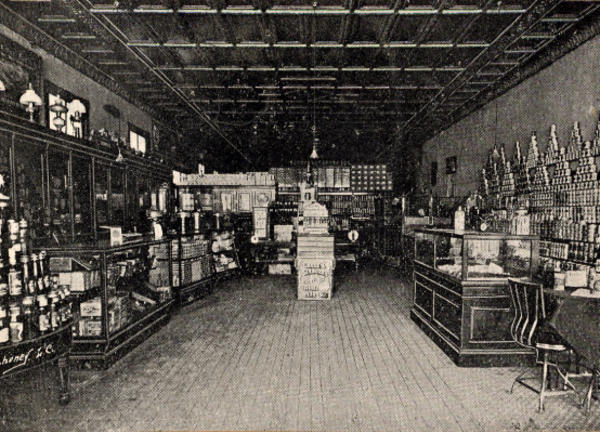

6 – 213 Pujo, ca.1914 – Caption by Maude Reid: “The First Convent in Lake Charles. ‘The Little Chateau,’ as the Sisters called it. This picture was taken just before the building was torn down. In 1882, six sisters from the Holy Cross Convent in New Orleans came to Lake Charles at the request of Father Kelly, the Catholic priest, to investigate conditions here with a view to establishing a school and convent…”
The O’Brien building, which would originally have been off the right edge of the photo, can now be seen at far left, where it was moved after O’Brien’s death and the sale of the property. Regardless of whether the Champagnes ever saw it in its original location, they lived for two decades knowing the old O’Brien house, which was then a boardinghouse, and the old convent, too.
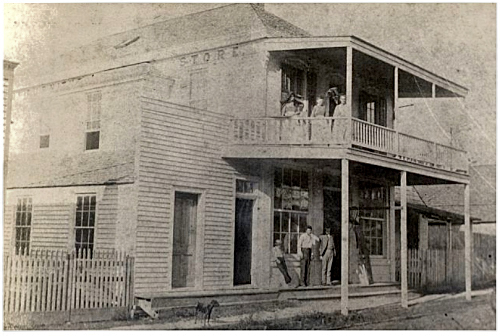
7 – 215 Pujo, ca.1890, Jerry O’Brien’s building after a 2nd story had been added for the family home, around the same time as the painting in photo 2.
Caption by Maude Reid – “Mr. O’Brien had a furniture store and cabinet making shop on the first floor and the family lived upstairs. To the right can be seen a bit of the tiny cottage that was the home of Madame Paul “Gascon” LaFargue, whose store was on the corner now occupied by the Calcasieu Marine Bank. The men of the family are shown downstairs, the women are on the upstairs gallery. Notice Mrs. O’Brien with the feather duster; the photographer came when house cleaning was going on. Notice, too, the typical, long skirted, slatted French sunbonnet on the lady at the left. These were worn by ladies desirous of protecting complexion.”
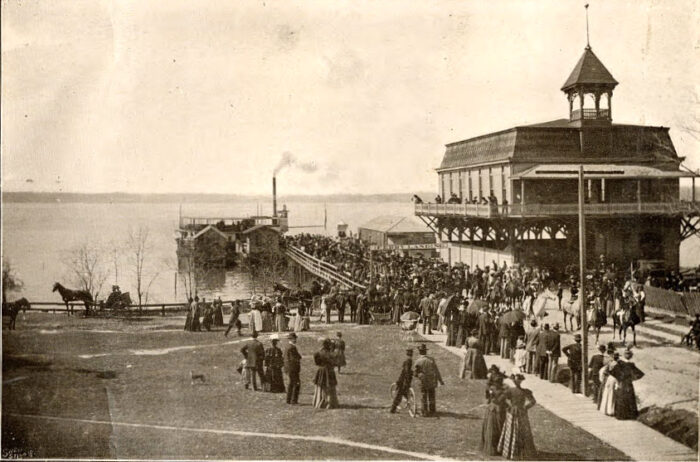
8 – Pujo St ferry landing and the old Market Hall. I love the “Sunday in the Park With George” feel of this shot, mostly due to the cyclist in the grass, one foot on the pedal, leaning toward his friend, but his head turned toward the coming parade. There’s a dog elsewhere in the grass, and several baby carriages as well. Miss Maude liked this photo, too, and captioned it several times, each with small differences, and one big contradiction.
Caption #1: “Arrival of a Mardi Gras parade, Feb.1895 – The King arrived with his retinue on his royal barge, the Hazel, and landing at the foot of Pujo street, marched up Ryan, Lawrence, Kirkman and down Kirby to Ryan street again, headed by our local band and followed by promiscuous maskers. The town was doing on a small scale the same celebration that New Orleans does so grandly each Mardi Gras day. The building at the right is the City Market erected in 1894 by F.W. Jolet and F. Gueble. The Mardi Gras parade ended that night with a ball upstairs over the market in the big hall where so many dances took place.”
. . . . or . . . . Caption #2: “The Old Market Hall – market downstairs owned by Joliet and Gueble – and hall for dancing upstairs. It stood at the foot of Pujo St at the ferry landing. Many fairs, “germans” , and musicales were given here for the benefit of our church in the ’90s. The picture taken in 1892 shows a grand Columbus Day celebration. Dr A. J. Perkins was King of the ball that followed.”
You be the judge, 🤣 but there are no Mardi Gras costumes, the parading horsemen have powdered wigs and velvet breeches on, the horsewomen fancy gowns, and I think I see a Spanish conquistadore’s helmet and a Christian cross on the saddle blanket of the first horseman.
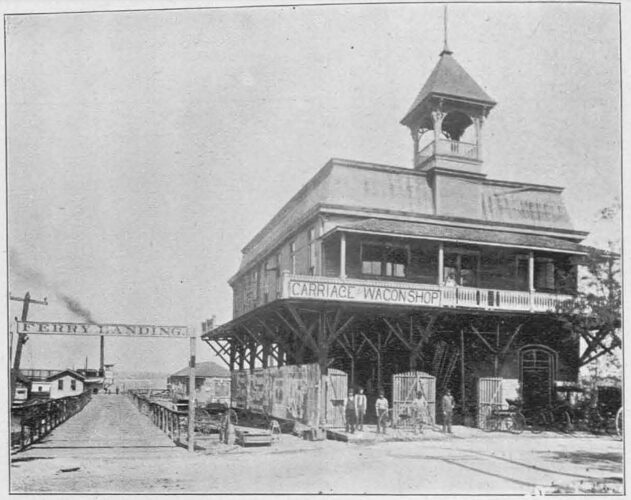
9 – “This building near the old ferry landing was a well-known spot in the early 1900’s. Upstairs – one large room – balls were given, ‘germans’ – they were called; church bazaars held and so on. Downstairs, originally a market place for Jolet and Gueble, eventually became a wagon shop – as shown. The steamer, ‘Hazel’ can be seen by the wharf at the foot of Pujo St.” Caption by Maude Reid
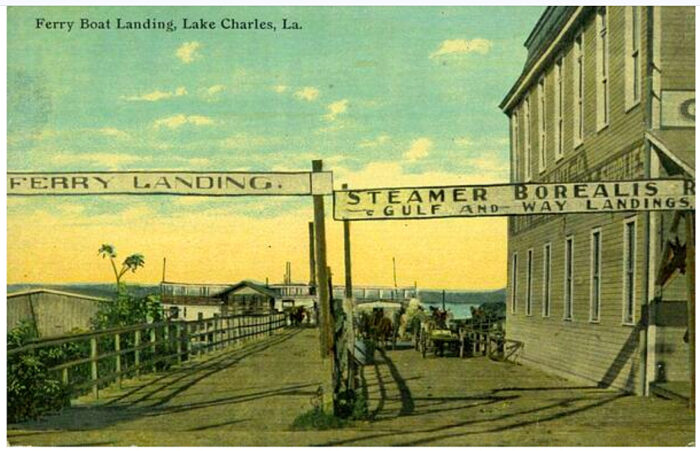
If any of the Champagne girls were sharp-eyed, they may have seen, all the way at the end of the ferry landing pier, the sign of an oyster and fish market and thought that that was worth a quick walk down to the water. And if they did, they’d have noticed, north of the Nettlerode/Foster home, two old homes, one belonging to the old founding father, Jacob Ryan, who owned the first lumber mill on the lake back when there were only a couple of houses cut from the forest that surrounded the lake.


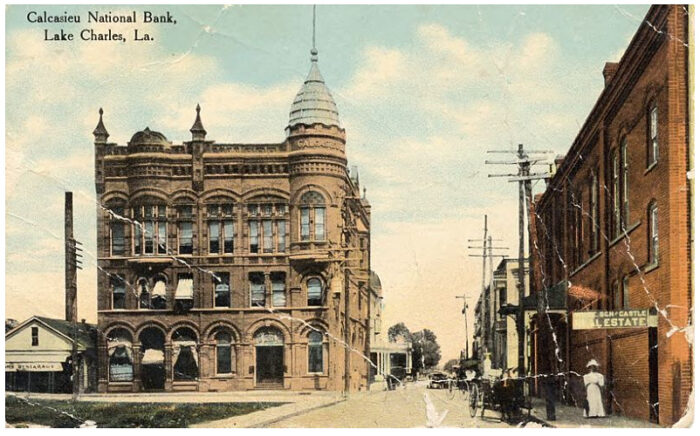
13 – From left to right, the Elite Lunch Room, the Calcasieu Nat’l Bank, the recently-built Majestic Hotel further down Pujo, and the edge of Von Phul’s drug store across Pujo are all on the east side of Ryan. In the foreground at far right is the side of Eddy Bros.’ store. The empty corner at left is where the old Lafargue home and store were before they burned down. The O’Briens’ 2-storey building has been moved toward the lake, to the opposite side of the old convent directly to the left of this photographer.
~~~~~~~ intersection Ryan at Pujo, east side ~~~~~~~
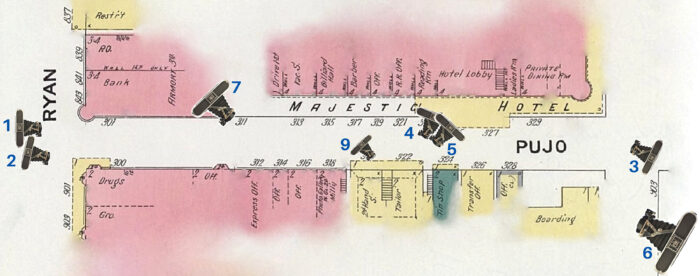

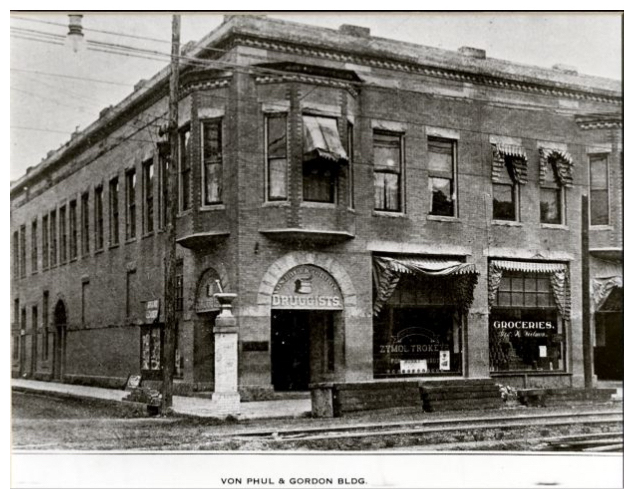
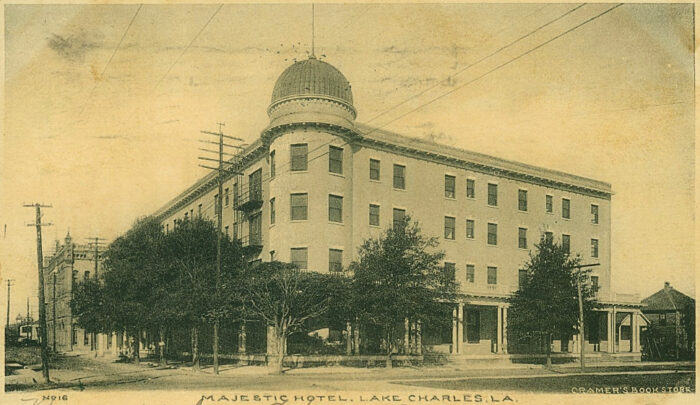
3 – It was the lower left corner of the Majestic Hotel shot that got me questioning whether the LaFargue compound or an empty corner lot greeted the Champagne girls as they passed by. Barely visible is the double verandah of the O’Brien house and the LaFargue store, as well as a mysterious bell tower that is not on any map and is too far to the right to be the Old Market Hall.
Given the bank, hotel and offices on that block of Pujo, it would be understandable if Tiwazzo and the girls saw no shopping opportunities to tempt them off of Ryan, except for one sign . . . OK Second Hand Furniture. The store was an interesting enough building, and I would’ve gone to look for that reason alone. In fact, there was no other building like it in Lake Charles that I know of, a store with Queen Anne ornamentation usually reserved for grand mansions.
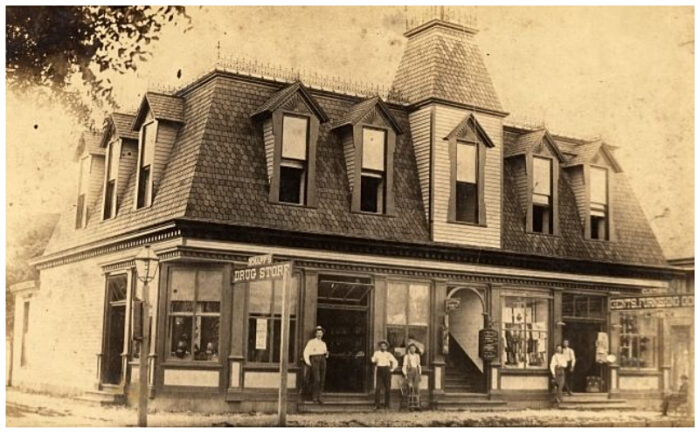
4 – Knapp’s had a mansard roof of different-colored shingles set in a geometric pattern and cut through on all four sides by many slender dormer windows, the front and center one fleshed out into a full turret with a raised mansard roof of its own. Across the upper edges of the roof, dormers and turret was beautiful iron grillwork, and along the bottom edge ran a row of Italianate denticulates (like teeth…’dental‘). Beneath the turret was an arched entrance to an enclosed staircase that bisected a wide expanse of store windows set into elegant millwork that continued in the Italianate style. The building had originally been Knapp’s drug store on the corner facing Ryan St, as pictured, before the brick Von Phul bldg replaced it. It was the most beautiful store in Lake Charles and much beloved by Miss Maude who captioned each of the several shots taken of it.
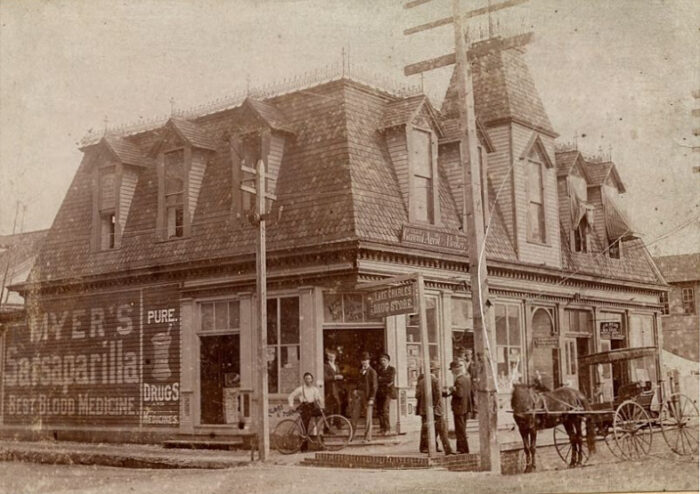
5 – Knapp’s was sold to the Meyer brothers, both doctors in Thibodeaux, and managed by Von Phul. The city had built new brick curbs and had installed telephone poles and wires. And the building had opened the corner window into a door, rented out offices to two different real estate brokers and rental agents and a public telephone station, and covered the exterior with advertisements. “Myer’s Sarsaparilla, Best Blood Medicine”… “Pure Drugs & Medicines” (the word Pure painted over what used to say W. A. Knapp’s) … skinny “Dr Meyer’s Emulsion” signs put sideways up the column bases.
Given such a presence in the archives, Knapp’s was only on the corner of Ryan and Pujo for 12 years or so, but when Von Phul’s built a new brick store, they didn’t demolish the old one. They moved it farther down the block and turned it to face Pujo, across from the Majestic where it sat next to a small former fire station which had been taken over by a 2nd-hand furniture dealer. By 1909, after a brick office building had been built behind Von Phul’s, the old Knapp bldg and its neighboring fire station were moved further back another 50′, but there this lovely building would stay for the rest of Tisolay’s years in Lake Charles.
I don’t imagine Tiwazzo would’ve cared about architecture, though, when they were on their shopping expedition; she’d’a seen that sign for OK Second-Hand Furniture and made a bee line (never mind the questionable promotional value of its name). By then, the store had moved out of the little fire house and into the more spacious Knapp bldg next door. Fresh in town with few of the things she had had in her Bayou Teche farm house, I’ll bet that of all the names of stores these women brought home with them for future reference that day, this one was first and foremost in Tiwazzo’s mind.
Knapp’s Mansard roof and turret, as well as the fire house tower, are clearly recognizable from the rear in shot 6 that seems to have been taken from a balloon in the sky, since there was no structure beneath it high enough to attain that vantage point… since, in fact, every structure beneath it had been burned to ash only months before. For all its architectural beauty, who knew that there was courage and drama in the ol’ girl’s very near future.

6 – The clear unobstructed view of the backs of these wood-frame buildings facing the Majestic was thanks to a fire in April of 1910 that burned everything up to that line, and no further. The new, ultra-modern Majestic had its own water supply which they used to spray the row of houses across the street between it and the fire, keeping them wet. Of all the time I’ve spent studying that fire and its aftermath, it took me a year to notice that a tiny white line in a bottom corner of one of them had captured the men on the old Knapp drug store’s roof, standing next to its turret, maneuvering the hose that had been suspended across Pujo St from the Majestic.
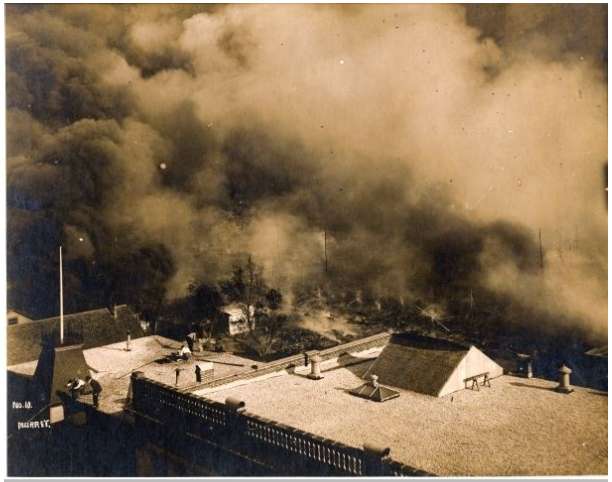
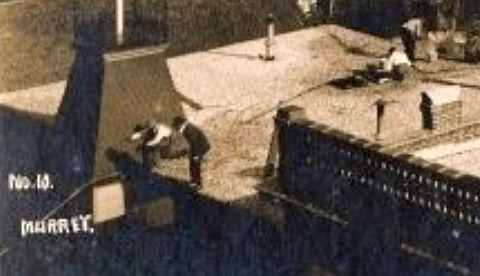
~~~~~~~ 900 block Ryan ~~~~~~~
The old Knapp building might have been one of Lake Charles’ favorite small buildings, but there’s no question what their favorite large building was. Tiwazzo and the girls had already seen it at the end of the 800 block, towering over the intersection across from where the LaFargue compound had been, and possibly still was, but I’ve saved it until the 900 block discussion because that was by far the town photographers’ favorite place to shoot it from.

Taken from the middle of the 900 block, looking north, the rooftop urns of Eddy’s store to the left and the upstairs bay windows of Von Phul’s to the right do make an interesting frame for the Calcasieu Bank turret which soars up and out of the frame. There were many shots from between 1900 and 1909 that I studied, trying to pinpoint when the LaFargue buildings came down and whether they were still around when Tiwazzo and the girls walked past since only one of them is reliably dated: the Prohibition parade in June of 1908. Toward that end, I’ve tried to put these shots in order of age based on the appearance of several things at different times, none of which are in the first photo: the Jewel Stoves sign on the electrical pole in front of a hardware store at left, the mortar & pestle on a column outside Von Phul’s drug store at right, a fifth cross-beam on the electrical pole on the LaFargue corner at left, a second streetcar track in 1905, brick paving shortly afterwards, the disappearance of the LaFargue buildings, the Prohibition parade in 1908, and finally, Von Phul’s awning and Rexall sign.


2 – Look at the telephone pole in front of Rock Hardware, at left. Sticking out off the right is a small, vaguely crown-shaped sign for Jewel Stoves, which the now-quite-spacious hardware store apparently carried. The sign may have been knocked off by horses’ heads and such one too many times, because the next photo shows it missing, and the one after that shows it put back, but a foot or so higher.
What’s a racket store, you ask? They were like variety or 5-&-10¢ stores, named for the racket their predecessors made in their horse and buggies, rattling their way through the neighborhoods with housewares and tools clanging against each other and salesmen yelling their presence. Sometimes they carried miniatures and models of larger appliances like stoves and washing machines to show customers, but that was becoming a thing of the past in town centers, as evidenced by Mr Braden’s store. Rock Hardware too, apparently.
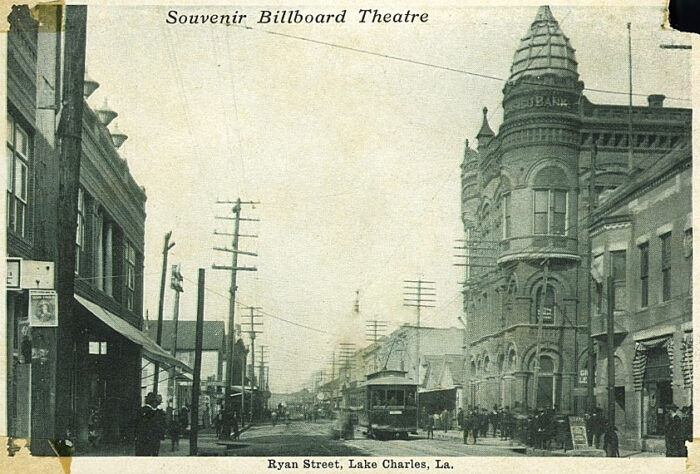
3 – The second streetcar line is in, a fifth cross beam has been added to the electrical pole on LaFargue’s corner, and the Jewel Stove sign has been removed from the electrical pole at far left.
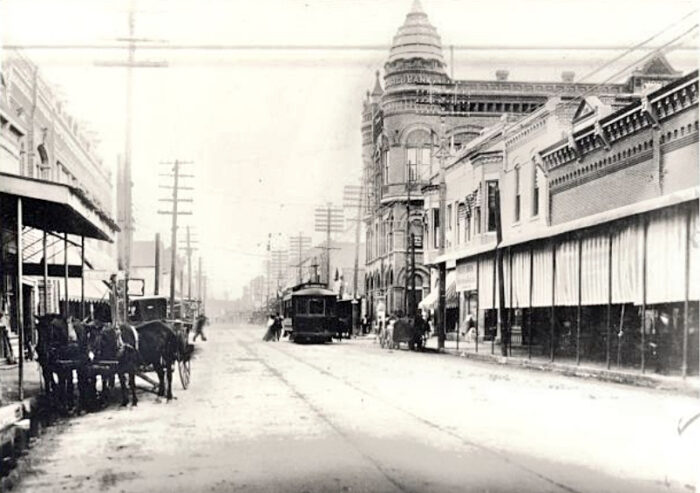
4 – Much the same shot as #3, but the Jewel Stoves sign has been put back about a foot higher than before, and the Von Phul’s mortar and pestle has been installed on the corner (gotta really blow it up to see it).
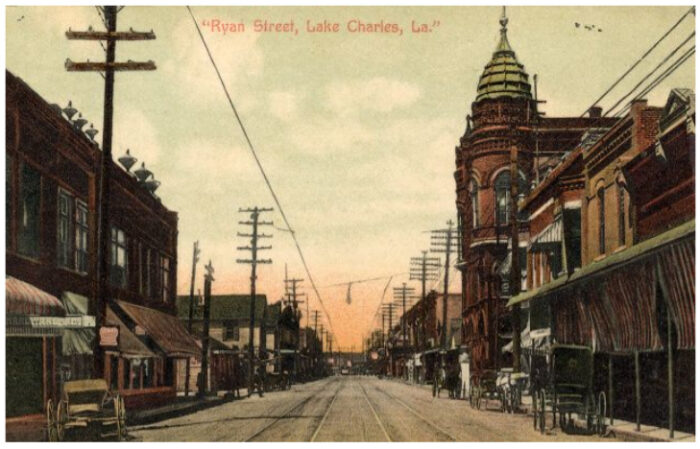
5 – (*correction, with apologies to Miss Maude – I’ve mentioned before that in several photos of Paul Gascon LaFargue’s corner property, Miss Maude’s captions confuse Julian Richard’s store with its next-door neighbor, the very similar Trepagnier and Hollins’ jewelry store, as though they are the same building with consecutive renters. I find this slip of Miss Maude’s interesting because of the timing. If that corner burned down in 1907 or early ’08, she would have been 25 and in nursing school in New York. It was the only decade in which she was not one of the most active and well-known participants in the town’s goings-on. Apparently, she came home and saw an empty corner lot and only one of the two 2-storey storefronts, and merged the 2 in her memory. )
In fact, both buildings were built by LaFargue as rentals in 1885 and 1887. He died in 1890 and a few years later, the jewelers bought their building from Madame LaFargue for $7000. She closed down her store and let it fall vacant, as well as the old Richard store (Richard having moved elsewhere), and they remained so until her own death in 1901. LaFargue left her well off and she may have preferred to dispense with landlord responsibilities, not needing the income. Perhaps it was her family up in Kinder that wanted her to quit, because the 1900 census shows that one of her grown granddaughters had come to live with her, taking up residence in the old corner store building next to her grandmother. By 1903, all the buildings, including the LaFargue home, have come back to life as other businesses, and the family, all back on the farm up in Kinder, seem to have divested themselves of the LaFargue holdings in Lake Charles.

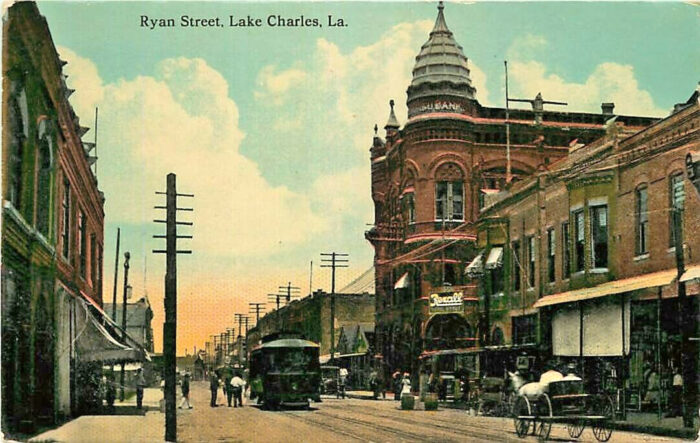
7 – In a classic meeting of the old and the new, the horse-drawn carriage at right is facing, head on, one of the first ‘horse-less carriages’ which is impatiently passing a stopped streetcar picking up passengers. And Von Phul’s, which has installed a wide shade awning, also sports a Rexall sign as one of the country’s earliest Rexall franchises.
With all the focus I put on this one scene, I’m still no closer to guessing whether the Champagne girls saw the LaFargue complex or an empty lot when they passed that corner. Oh, well.
~~~~~~~
The lower half of the 900 block was very different from the upper, whose modern brick shopping strip gave way to very old wooden storefronts that had never been replaced, most of them dilapidated and forgotten as the 4-block shopping strip transitioned into the religious and civic center of the town. One large, looming old structure was the Lake Charles Opera House, just south of Mrs. Gunn’s book store. Built ca.1887, it was only 20 years old when Tiwazzo and the girls walked by, nevertheless, they saw an abandoned building that had already warranted warnings from the city fire department recommending the demolition of the building as soon as possible. What a shame that, warnings unheeded, the Champagnes did indeed see the dried-out tinderbox of a theater still standing, a ticking time bomb that would set off the devastating 1910 fire.

Croom’s bakery, a tiny wooden, otherwise-unassuming storefront, sported a crown-shaped parapet at the top of its façade that stands out in several photos of this block.

9 – In 1882, Meyer’s drug store on the corner, upper right, would not be replaced by the brick Eddy Bros. building for another 18-20 years. The empty lot at far left would not contain the Williams Opera House (later named Lake Charles Opera House) for another 5 years. The house in the lower right corner with the roofline parallel to Ryan St will soon be torn down to make way for Sol Bloch’s store. But Croom’s Bakery, bottom center, is there with its crown-shaped parapet and will be there 25 years later to see the Champagnes walk by.

10 – On July 4th of 1889, Croom’s bakery’s parapet and portico shade parade watchers from the morning sun, as does Sol Bloch’s store next to it and Knapp’s drug store after that with a flag flying from its turret. Across the street, below the newly-built opera house, is Capt. Bryan’s home and store-turned-real estate office which presides over the corner where the west side of Ryan St opens out onto the town square. The parade has stopped in front of the courthouse, unseen off the lower left corner of the photo, which was only a small 1-story wood frame structure at the time. However, the fact that Capt. Bryan had recently added real estate to his business interests speaks to the great changes that have already begun in Lake Charles. The 1890s saw northern investors and lumber barons take the town’s lumber industry into ‘the big time’, pour resources into modernizing civic and commercial infrastructure, and build mansions up and down Broad St that would set the tone for Lake Charles’ cultural development.
The year this parade shot was taken, the budding entrepreneur J. A. Landry (whose sister Regina would become my great aunt Carmen’s mother-in-law) was planning the town’s first public utilities company to the little boom town that would bring in the town’s first ice factory the following year, followed by electric lights at the street corners, water and plumbing, and a streetcar. A shot of Croom’s and its surroundings from 10 years later exhibits some of these changes.
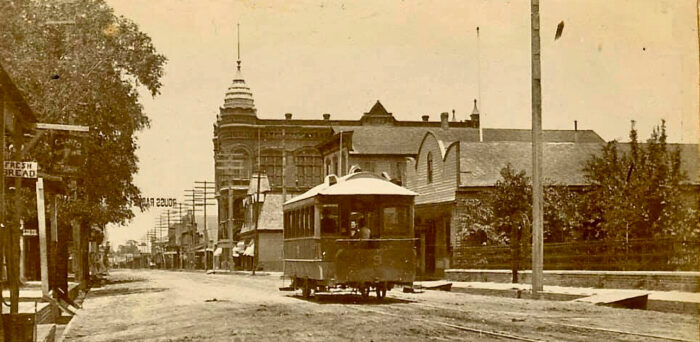
11 – 1899. Ten years later, an electric streetcar, no longer dependent on mule-team power, is about to pass Croom’s bakery. Electric poles have sprouted alongside Ryan St (foreground wires mysteriously photoshopped out?). And the massive brick Calcasieu Bank building, one of the first of the big brick structures, ushers in Ryan St’s transition from all-purpose family neighborhood of wooden cottages and shops into a specialized brick business district.
The Rouse’s Racket Store sign which spans the street will not be suspended from its narrow, 2-story wooden storefront for much longer (seen in a previous photo with subsequent tenant, Mrs. Gunn’s book & stationery store). When the lovely mansard-roofed Knapp’s drug store is replaced by Von Phul’s big brick building, a sprawling 1-story brick storefront built next to it will become the new home of Rouse’s.
The ‘fresh bread’ sign at far left, though, serves as a symbol of the dying past, since a confectioner and baker didn’t occupy the tiny building that had been Bryan’s real estate office until his death 2 years before this shot.
In 1907, 8 years later, I doubt that Tiwazzo and the girls, reaching the end of their shopping expedition, appreciated that there was real history in that last decrepit old building on the corner, or even noticed it in light of the magnificent courthouse, city hall, and Catholic church compound their eyes could feast on instead. Nothing about the abandoned 2nd floor of the old store-turned-office hinted that it had once been the home of a remarkable man, one of the more unsung pioneers of Lake Charles, and his thriving family of 10.
A rural farm boy from 50 miles upriver who loved education, he became a teacher while trying to continue his own education. The Civil War interrupted his degree program, but he served with distinction and leadership, forming several militias and attaining the rank of captain, after which he settled in the new settlement of Lake Charles where he resumed teaching. In 1868, he was elected to be the first mayor of the newly-incorporated town, and within 3 years, he had married a teacher, opened a large general store which they lived above, then taken over the LCh Echo newspaper. Over the years, he was councilman, member of the police jury, and on the town’s early school board. With few civil officials, no city hall, and a courthouse barely bigger than his store, the building probably saw a lot of civic business done by the founding fathers of the settlement while they sat with Bryan in the store’s doorway in the shade of the chinaball trees. Not quite 20 years later, with his finger on the pulse of Lake Charles’ growth and promotion, Capt. Bryan went into the real estate business, converting a small building on the property into an office.

12 – In 1888, when this picture was taken, Capt. Bryan apparently still had his store up and running since Constable Harmon, Bryan’s younger half-brother by his mother’s second marriage, is standing next to several well-dressed mannequins. The small building at far right could have been Bryan’s real estate office, and would eventually be rented to a confectioner/baker. The town’s public water well can be seen where the barrel and bucket sit at the corner off the curb’s edge. Buggies are parked on the corner of the courthouse square whose horses must have been stabled nearby. A string of liveries in the next block no doubt did a brisk business boarding horses by day, hitching and unhitching for well-dressed government workers, lawyers, and businessmen, or ladies, or independent ‘taxi’ drivers who didn’t want their horses without water or shelter from the hot sun for long periods.
The following year in 1889, 10 days before the July 4th parade in photo 10 (which the family might have missed), his eldest daughter married one of the presidents of Baylor college in Waco, Texas, which apparently opened up an opportunity for the education-loving, former teachers to put their 3 sons in school there. The year after that, the 56-yr-old Bryan retired from the newspaper and sold it to another in a merger, after which the family started to go back and forth to Waco. Capt. Bryan died in 1897, with Mrs. Bryan following 2 years later, and then several little shacks get patched into the space between the old store and office, then rented to itinerant food vendors, a shoemaker, and a barber. The upstairs residencewas abandoned, a remnant of a time when the tiny outpost barely had roads or a name, and that is how the Champagnes found it in 1907.
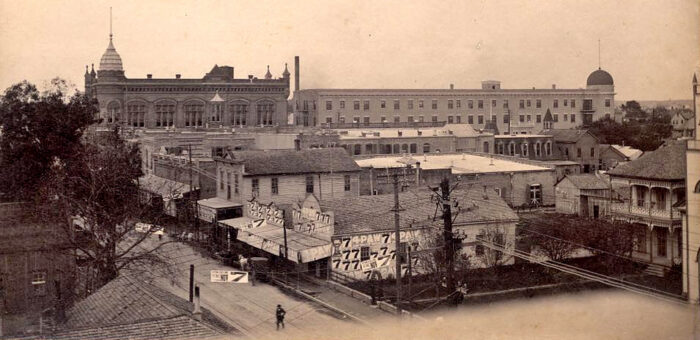
13 – The Priest’s rectory at far right and Bryan’s roof, far left, mark the end of Tiwazzo and the girls’ initial exploration of the Ryan St shopping strip for their immediate needs in moving into the house at 511 Moss St… as I imagine it anyway. They may have looked around, curious about the church they knew they’d be going to on Sunday, but they still had to deal with getting all their purchases home, either delivered by the store, or by a hired wagon. Sunday would come soon enough, though, when the family was very likely more relaxed, not only going to church, but taking a family stroll to explore the town square, the waterfront, and maybe going home by way of Broad St to see the mansions of the wealthy lumber barons from the north. This, the last of the 3 ‘First Week’ posts, follows.
~~~~~~~ (cont’d on the next post) ~~~~~~~
================================================================================
[for my own organization… 64 screen pgs, 67 shots, – 700 block Ryan, 4 . . . intersection Ryan and Broad (700-800), west 5, east 6½ . . . Hutchins’ corner at Broad , 5½ . . . 800 block Ryan, 12.5 . . . intersection Ryan and Pujo (800-900), west 11, east 6 . . . *Note – Obrien d.1899 at 61 after long, wasting illness, LaFargue in 1890 at 74, Widow LaFargue in 1901 at 76] . . . 900 block, 13 ½ ]